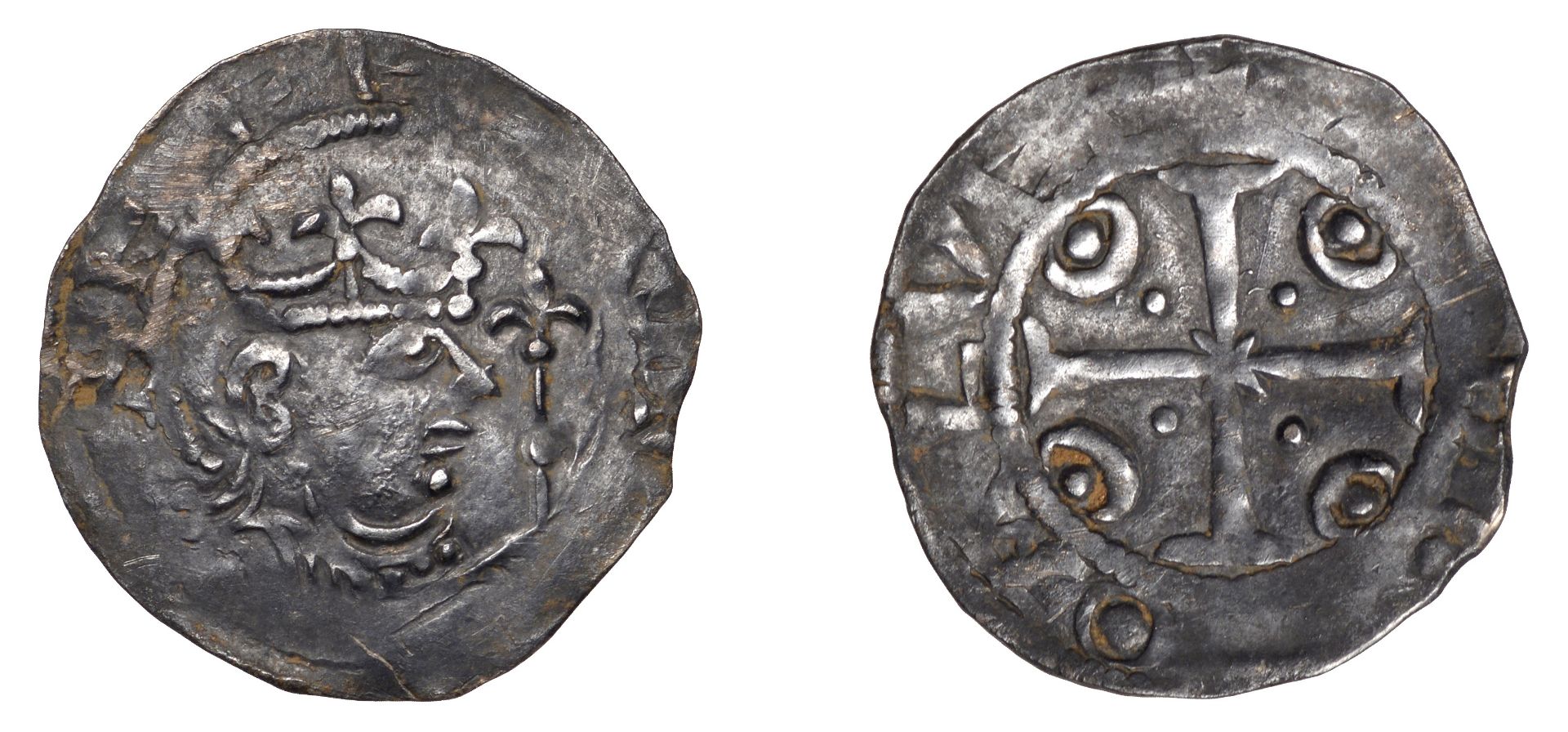A New Baronial Penny from the mint of ‘Alve’ Stephen (1135-1154), Baronial Issues, Penny, Profile/Pellets-in-Crescents type, Alve?, uncertain moneyer, +[–]sefe[–], small bust right holding sceptre, ornamental s with large crescent-shaped serifs, rev. +[–]d o[–] o alve:, long cross with saltire imposed over centre, pellet and pellet-in-crescent motif in each angle, ornate annulet-like o and chevron-barred a, 1.04g/5h (Mack –; cf. N 949). Peripheral weakness and with a few light marks consistent with being a field find, otherwise very fine, the portrait well struck up and of singularly elegant style and with an unrecorded mint-signature; excessively rare thus, and presumed UNIQUE £5,000-£6,000 --- Provenance: Found near Bossall (North Yorkshire), January 2023 (EMC 2023.0038) Presented here for sale is a most unusual penny of the twelfth century. Struck from dies of accomplished workmanship and incorporating what appears to be a previously unattested mint signature, the coin in question is of great numismatic interest. Before turning to the matter of attribution, it is first appropriate to highlight several of the coin’s more irregular stylistic features. The bust is well-sculpted with a heavy jowl and a large almond-shaped eye; the reader’s attention is drawn in particular to the rendering of the figure’s ear, a most unusual feature for this period. Further, both legends (obverse and reverse) make use of ornamental letters: the S in the king’s name is formed of a snaking body with large crescent serifs, while the A on the reverse is chevron-barred, and separated from the preceding text by an ornamental annulet. These characteristics result in a coin of distinct style and artistic quality, struck from dies which bear little resemblance to those produced at the ‘official’ Fitz Otto workshop in London. During this period, the use of ornate letters and decorative ornaments is usually associated with the Baronial coinage and the employment of Flemish or European moneyers, evidenced most clearly in the York group. This arrangement, when considered alongside the mint-signature, suggests a context outside of the normal mechanisms of coin production. In turn, this recalls William of Newburgh’s description of monetary disorder during the Anarchy: ‘in England there were in a sense as many kings, or rather tyrants, as there were lords of castles. Each minted his own coinage, and each like a king had the power to lay down the law for his subjects’. On account of its reverse type, there is an initial temptation to associate this coin with the ‘Pellets in Annulets’ coinage struck under David I as king of Scotland (Stewartby Gp IVc). While certainly plausible, such an assumption seems far from certain. Stylistically, the coin is both distinct from, and far superior to, the Sterlings produced at the mints under David’s control. Further, the coin appears to have been struck to a lighter weight standard than that employed for the early Scottish coinage (which consistently produced Sterlings of around 1.40g). It should also be noted that the mint reading alve (taking the preceding character to be an ornamental annulet) finds no find match in the Scottish series. While it is true that this signature is also unattested south of the border, and that both scenarios require us to propose a new mint-place, it seems more likely that a temporary mint would be located in England; at this time Scotland’s coinage was in its infancy with production focused on a select few locations, whereas in England the system of small (and sometimes occasional) provincial mints was, by this point, firmly established. In addition, it is worth remembering that the ‘Pellets in Annulets’ type employed by David was actually copied from the English coinage; introduced under Henry I (types 8 and 12), the type’s use was continued for select southern Baronial issues during the Anarchy, including a curious piece which also incorporates the small central saltire seen on our coin (Mack 274). An alternative approach would be to take the coin’s light weight as a cue towards its point of origin. At 1.05g the coin appears to have been struck to the same distinctive weight standard employed for the south-western Baronial issues, including the coins struck under Matilda and Robert of Gloucester at Bristol. Following this thread we can turn to consider the enigmatic mint signature carried by our coin. Domesday Book contains numerous place-names beginning ‘Alve’. Of these, the largest and most significant appears to have been the royal manor of Alveston in Gloucestershire, afforded a value of £60 in 1086. The manor appears to have come into the possession of Henry of Anjou during the course of the late 1140s. Its position before that point is unclear, although being located where it was it is plausible that king Stephen travelled through the estate following his release from imprisonment in Bristol in November 1141. However, once again there are obstacles which prevent this attribution from being accepted outright. One wonders why a coin produced in an area of Angevin control, adhering to the ‘Angevin’ weight standard, would name king Stephen on its obverse? Further, given the discovery of this coin in North Yorkshire, we might expect it to have been struck at a more northerly mint.



